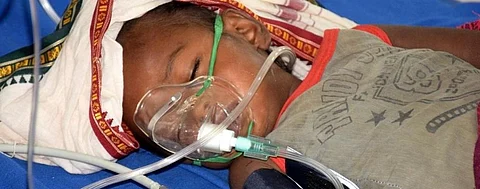

Bihar Minister of Health Mangal Pandey has admitted that an outbreak of Acute Encephalitis Syndrome (AES) had caused the death of 57 children in north Bihar.
According to Pandey, out of the 57, 47 had died in the government-owned Sri Krishna Medical College and Hospital (SKMCH) in Muzaffarpur and 10 had died in the privately-owned Kejriwal hospital.
After Pandey’s admission, two more children died at SKMCH on June 14.
Pandey’s admission is significant as earlier this week, he had refuted the reports of children dying due to AES in Muzaffarpur and had claimed they had died due to hypoglycaemia.
It took Pandey 12 days to visit Muzaffarpur after the initial reports of children dying from AES first filtered in on June 1 and 2.
Pandey visited SKMCH in Muzaffarpur, where most victims of the epidemic have died or are undergoing treatment.
He inquired about children undergoing treatment and held a meeting with doctors.
During the 12-day period, Pandey was more active in Delhi, meeting Union Minister of Health Harsh Vardhan to discuss the situation in Muzaffarpur after his trip abroad, and in Patna, meeting the leaders of his party, the Bharatiya Janata Party.
Pandey told media that six additional ambulances would be deployed at the SKMCH and a new ward of 100 beds would be set up for it soon.
Meanwhile, the central team visiting Muzaffarpur to inquire into the cause of children’s deaths, has reportedly said that most of the cases reported are due to encephalopathy.
The team has also advised SKMCH to take up research and concentrate on a regular follow-up of patients. There should be a separate research wing under the department of microbiology and pathology and serum samples of patients should be preserved for rechecking, it said.
The team recommended the bed strength of the paediatric ICY at SKMCH be increased from the existing 14 beds to 100.
All eyes on the rain
Everyone in the affected areas is now awaiting the arrival of the monsoon rains for the AES outbreak to subside.
“We are yet to know the exact reason behind the outbreak. Investigation and research will continue. But one thing is certain: the disease is usually controlled only after the arrival of monsoon rains,” said Gopal Shankar Sahni, head of the paediatrics department at SKMCH.
Sahni was supported by regional additional health director, Ashok Kumar Singh. “The three Hs — heatwave, humidity and hypoglycaemia — are causing the deaths of children, who are suffering from symptoms akin to AES. Rains will reduce the effects of the disease. It has happened in the past too,” Singh said.
On June 10, Bihar Chief Minister Nitish Kumar himself said that something linked the disease with hot weather and the monsoon. “This disease broke out ahead of the rains. It is a matter of concern that every year, children are dying due to it.”
In Muzaffarpur, the parents of children suffering from symptoms akin to AES have been passing sleepless nights as monsoon rains are expected only after June 20.
“We are praying for monsoon rains. Only the rain god can save our child as doctors informed us that the monsoon will help to suppress the virus causing the disease," Mahesh Kumar, father of a 6-year-old boy, who is fighting for his life in hospital, said.
Kamla Devi, mother of a girl who is in a critical condition, said she, along with other helpless parents, were praying for the rain. “Now, our entire hopes are with the monsoon,” she said.
But officials of the India Meteorological Department, Patna, said there was little chance of the monsoon entering Bihar this week. “The monsoon’s arrival will be delayed by 10 days,” an official said.